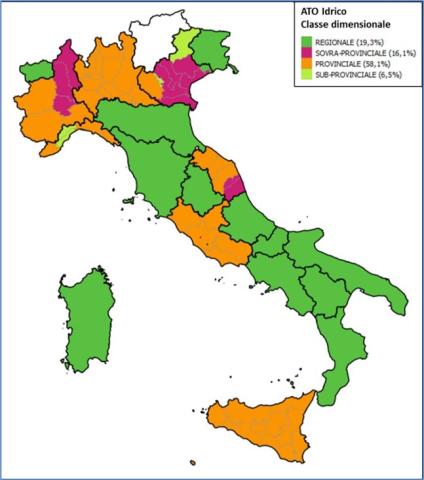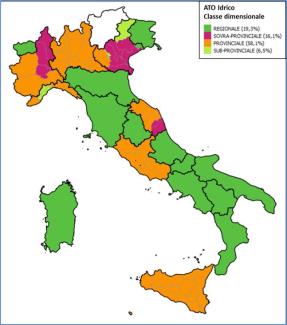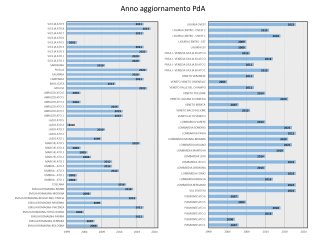Panel 1
Filippo Bianchi, Luigi Di Micco, Saverio Venturelli
In water resource management, the Area Plans (PdA) serve as a tool to plan and program activities for the Integrated Water System (SII). This system encompasses public services such as water abstraction, conveyance, and distribution for civil uses, as well as sewage and wastewater treatment. The indicator provides a national overview of the Area Plans currently in force within the Optimal Territorial Areas (ATO) into which the territory is divided, in accordance with current legislation.
At present, the national territory is divided into 62 ATOs, demarcated by the regions based on rules contained in the Environmental Code (Legislative Decree No. 152 of April 3, 2006, Part III). This legislation does not set minimum dimensional limits for the ATOs but outlines criteria for their delimitation, which refer to:
- (i) Basin unit and location of resources, and constraints for the destination of these resources for the affected urban centers.
- (ii) Management unity (i.e., provision of all components of the integrated water service across the entire ATO by a single management entity).
- (iii) Adequate management size (defined based on physical, demographic, and technical parameters).
The indicator provides information on the drafting and/or updating status of the Area Plans (PdA) at the regional level. These are planning tools linked to defining the quality objectives for the Integrated Water System (SII) and identifying the necessary actions to achieve them.
The Integrated Water System includes public services for water abstraction, conveyance, and distribution for civil uses, as well as sewage and wastewater treatment services. This also encompasses services for multipurpose abstraction conveyance and mixed-use (civil and industrial) treatment services. Management must comply with principles of efficiency, effectiveness, and cost-effectiveness, respecting national and community norms (Article 141, Paragraph 2, Legislative Decree 152/2006 and subsequent amendments).
The PdA are developed by the Ambit Government Entities (EGA), organizations identified by the regions for each ATO. All municipalities within the ATO are required to participate in these entities, transferring the exercise of their competencies in managing the SII, including infrastructure programming.
To provide information on the progress of the PdA to monitor the implementation of current legislation on the SII, which requires the drafting of the PdA. These are planning tools aimed at proper programming and management of the water infrastructure envisioned at the ATO scale. Their implementation is crucial in the complex framework of water resource protection and management.
Legislative Decree No. 152/2006 requires that the PdA consist of the following documents:
- Infrastructure Survey: Identifies the status of the infrastructure to be entrusted to the SII manager, specifying its operating conditions.
- Intervention Program: Identifies extraordinary maintenance works and new projects to be carried out, including upgrading existing infrastructure. It ensures the achievement of at least minimum service levels and satisfies overall user demand. The program specifies the objectives to be achieved, the infrastructure planned, and the implementation timelines (PdA implementation plan).
- Organizational and Management Model: Defines the operational structure through which the manager delivers the service to users and implements the intervention program.
- Economic and Financial Plan: Provides an annual forecast of management and investment costs, net of any non-repayable public funding. This includes an annual projection of water tariff revenues collected from users, covering the entire duration of the water service concession.
Thus, the PdA aim to provide a snapshot of the current state of water resources and available infrastructure to identify necessary interventions for addressing emergencies and critical issues in the target territory, ensuring compliance with service levels set by current legislation.
Panel 2
ReOPEN spl – Lo stato dei servizi idrici, monitor idrico, schede regionali
Excessive spatial-temporal fragmentation of information, given the number of ATOs
Data quality assessment
ATO (Optimal Territorial Areas)
Nazionale, regionale
Ottobre 2023
Indicator assessment
Verification of the presence/absence of the PdA in the reference territory.
Currently, there are 62 ATOs. Regarding Area Planning, only 5 ATOs do not have valid PdA, whereas the other 57 ATOs have valid PdA, though these may not have been recently approved or updated.
In recent years, regions have been updating the regulations concerning the Integrated Water System (SII). Consequently, the Ambit Government Entities have been drafting, revising, or updating the PdA. Over the past few years, there was an increase in the number of annually updated plans (Figure 3). However, in the past year, no plans have been updated.
Data
Table 1: Progress of the Areas Planes
ReOPEN SPL, The state of water services - water monitor - regional cards




12 out of 19 regions (Abruzzo, Basilicata, Calabria, Campania, Emilia-Romagna, Friuli-Venezia Giulia, Molise, Puglia, Sardinia, Tuscany, Umbria, and Valle d’Aosta) have opted for regional ATO coverage (Figure 1), representing 63% (excluding the autonomous provinces of Trento and Bolzano).
When considering different size classes based on the number of ATOs, 20% of Italian ATOs cover an entire region. Regarding Area Planning, 24 ATOs/sub-ATOs updated their PdA during the last four-year period (2020–2023), and 6 ATOs (Valle d'Aosta, Tuscany, Basilicata, Puglia, Sardinia, Calabria) of the 12 with regional extension have a unified PdA (Table 1).
From Figure 3, it can be seen that 46% of ATOs/sub-ATOs have updated their PdA in the last 10 years (since 2015). Between 2020 and 2023, a greater annual variation in PdA updates was noted compared to previous years. This indicates an increase in the number of updated plans during those years, resulting in a positive impact on the assessment of water resources and infrastructure needed to address potential emergencies and critical issues in the territory. However, no plans appear to have been updated in 2024.